Astronomer Dr. Peter Jenniskens [Portrait (3.2 Mbyte)] is a Research Scientist with the Carl Sagan Center at the SETI Institute and works on mission projects at
NASA/Ames Research Center in Moffett Field,
California, and on research topics that relate to interstellar and interplanetary matter.
Research Interests:
Meteor showers -
Jenniskens is an expert on meteor showers, and is known for identifying the parent body of the Quadrantid shower:
a minor planet called 2003 EH1. Main belt asteroid 1999 TY224 was named (42981) "Jenniskens".
[Overview of airborne missions]
- Jenniskens predicted the return of the unusual alpha Monocerotid shower in November 1995 and led a ground-based observing campaign to document such shower from the crossing of a long-period comet dust trail for the first time.
- Jenniskens was the Principal Investigator of NASA's first Astrobiology mission,
Leonid MAC, an airborne campaign to explore the 1998 - 2002 Leonid storms and study meteoroids and their paths from extra-terrestrial to
terrestrial matter.
- He predicted the return of the unusual Aurigid shower from dust ejected around 4 AD by long-period comet Kiess on September 1, 2007, and was the Principal Investigator of the Aurigid Multi-Instrument Aircraft Campaign (Aurigid MAC), an airborne mission that deployed from NASA Ames to study this meteor outburst.
- This was followed by a study of dust ejected by comet 8P/Tuttle (Ursid MAC) in December 2007, and a mission in January 2008 to study the Quadrantid meteor shower for clues to its date of origin (Quadrantid MAC).
Artificial meteors -
Jenniskens has applied meteor shower observing techniques to study the reentry of various spacecraft.
- He is the Principal Investigator of the Hayabusa Re-Entry Observing Campaign, a NASA led mission to study the reentry of the Japanese Hayabusa spacecraft over Australia in June of 2010.
- He is the Principal Investigator of the ESA-NASA co-sponsored ATV-1 "Jules Verne" Multi-Instrument Aircraft Campaign, in a collaboration with J. Hatton, a mission to monitor the safe reentry of ESA's Autmoated Transfer Vehicle on its maiden voyage on September 29, 2008, and validate fragmentation models.
- Before that, he was the Principal Investigator of NASA's Stardust Sample Return Capsule Entry Observing Campaign, an airborne mission that monitored the entry of the Stardust Sample Return Capsule on January 15, 2006, as a system field test for its thermal protection system and on a mission to learn about meteors from what was the fastest entry of a man-made object in Earth's atmosphere.
Ice - His
work at the Space Science Electron Microscopy Lab has led to the discovery that unusual
forms of water ice play an important role in astrophysics.
DIBs - His
astronomical observations of Diffuse Interstellar Bands in the visual
and near-infrared absorption spectra of interstellar matter, in collaboration with
F.-X. Desert, provided the first overall view of the Diffuse Interstellar Band spectrum.
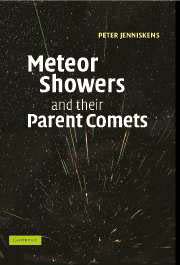 Publications:
Publications:
List of Publications.
He is author of the book Meteor Showers and their Parent Comets, a comprehensive (790 page) and richly illustrated overview of the field of meteor astronomy for both amateur and professional astronomers, published by Cambridge University Press in 2006. A paperback re-print was issued in 2008.
From the hardback review: '... I expected this to be the long-awaited standard text on the subject. As it turned out, I was not disappointed. ... It is, above all, a good read.' The Observatory
Associations:
Peter Jenniskens is chair of the Task Group on Meteor Shower Nomenclature of the International Astronomical Union's (Commission 22), former chair of the
professional-amateur cooperation working group (1997-2006), and a former secretary of IAU Commission 15. He is member of the American Astronomical Society (Division of Planetary Science). He has organized special sessions for meetings of COSPAR, the AGU, and the EGS, and was (co-) editor of special issues of the journals Meteoritics and Planetary Science, Advances in Space Research, and Earth Moon and Planets.
2004 - present: Artificial meteors
Peter Jenniskens is the Principal Investigator of the
Stardust Sample Return Capsule Reentry Observing Campaign (Hyperseed MAC), including a similar mission to study the return of the GENESIS sample return capsule. Results include:
This work has lead to the following discoveries:
- Stardust:
- Reconstructed Stardust SRC trajectory in good agreement with pre-flight predictions
- Measurement of the surface temperature profile of the Stardust sample return capsule: discriminates among heat flow and ablation models
- Detection of emission lines and molecular bands from the shock radiation: oxygen line emission underestimated, validation of shock chemistry models
- Detection of emission lines and molecular bands that originate from the ablated heat shield material: validation of ablation models
- Detection of atomic lines from a white paint layer used for thermal protection
- Genesis:
- Measurement of the surface temperature profile during descent of the Genesis sample return capsule: temperature stays high longer than predicted.
(<<)

1998-2003: The Leonid storms
Peter Jenniskens is the Principal Investigator of the
Leonid Multi-Instrument Aircraft
Campaign (Leonid MAC),
with missions in November 1998 (to Okinawa, Japan) and 1999 (to Israel).
The missions are organised in collaboration with Maj. S. Butow of the U.S. Air Force, Mr.
Mark Fonda of the NASA Ames Exobiology Branch, and
an international team of instrument PI's, key players being Dr. Chet Gardner, Dr. Ray Russell,
Dr. Joe Kristl, Dr. Hajime Yano, Dr. Jiri Borovicka, Dr. Bob Hawkes, Dr. John Plane, Dr. Mike Taylor,
Dr. Gary Swenson, and Dr. Bill Smith. The research aircraft were operated by the 452nd Flight Test Squadron (Edwards AFB, CA) and NCAR/RAF (Boulder, CO)
This work has lead to the following discoveries:
- 1998:
- the first detection of resolved first positive N2 bands and atomic lines that could be compared directly to laboratory air plasmas. This led to a new physical model for the rarefied flow about a meteoroid, that has most visible emission come from the wake and not from the head of the meteor (Jenniskens, Laux, Boyd, Popova et al.)
- the discovery of an early release of sodium compared to magnesium, interpreted as evidence for fragmentation (Borovicka et al.)
- the detection of jet-like structures in some meteor images, with a unknown cause at the time (LeBlanc et al.)
- first measurements of the lifetime of neutral atom debris trails (Chu et al.)
- first correlation of meteor magnitude with the density of neutral atom debris trail (pending data reduction support)
- first detection of meteors at mid-IR wavelengths, unexpected lightcurve anomalies with unknown cause (Rossano et al.)
- a new mechanism of luminosity at high altitudes, cause unknown (Spurny et al.)
- persistent train time evolution, leading to a new model for tubular persistent trains (Jenniskens, Nugent, Plane)
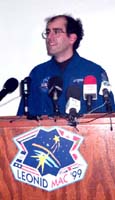
- 1999:
- detection of organic fingerprint in persistent train spectra (Russell et al.)
- confirmation of jet-like structures, proof that these are meteoroid fragments ejected at high speed - much larger region around meteor may be processed (Taylor et al.)
- discovery that 1998 and 1999 Leonids had different light curves, attributed to more coarse breakup of 1999 Leonids (Murray et al.)
- first detection of meteoric debris in path of fast meteor at high altitude (Borovicka and Jenniskens)
- First measurement of decay of meteoric vapor with time (Borovicka and Jenniskens)
- Discovery of FeO emission being dominant contributor to visible luminosity in trains (Jenniskens et al.)
- Near-real time flux measurements, rate profile is Lorentz shaped (Jenniskens et al.)
- Lack of breakup of particles in interplanetary medium (Gural and Jenniskens)
- Detection of OH increase with shower flux (Kristl et al.)
- Observation of first sprites and elves over Europe, detection of central dark hole that confirms elf model (publication in preparation)
- And an amazing video record of the shower was obtained on High Definition TV, recording peak rates of 6-7 meteors at a given time. Our live internet and TV broadcast of the storm was watched all over the world.
- 2001:
- A halo and shock-like feature in bright (< -3 magnitude) Leonids (Stenbaek-Nielsen et al.).
- Measurement of mass and speed dependence of meteor air plasma temperatures (Jenniskens et al.).
- Detection of N2+ in meteor emission (Jenniskens et al.).
- Investigation of hydrogen emission in meteors as a potential marker for the exogenous delivery of organics and water (Jenniskens and Mandell).
- Meteors do not break exogenous organic molecules into high yields of diatomics (Jenniskens et al.)
- Detection of recombination line emission in Leonid meteors (Borovicka)
- Detection of OH emission in Leonid meteors (Abe et al.)
- Persistent train in the wake of a bright Taurid fireball
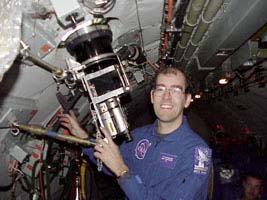
- 2002:
- Confirmation that dust trails are narrow when crossed through center, and slightly shifted from predictions (Jenniskens et al.)
- Detection of Filament component post perhelion (Jenniskens et al.)
- Detection of variation in sub-mm emissions of upper atmospheric molecules due to aurora, but not due to a meteor shower (Kunzi et al.)
- Detection of sodium line ratio variations (Slanger et al.)
- First near-IR (0.9 - 1.4 micron) spectrum of meteors (Taylor et al.)
- Discovery that meteor halo size correlates with meteor brightness (Stenbaek-Nielsen et al.)
- Confirmation of 3.4 micron feature detection in thermal infrared spectra of persistent trains (Rossano and Russell)
- Lack of airglow variations during the meteor storms (Plane et al.)
Results from the 1999 campaign were published in "Leonid Storm Research", edited by P. Jenniskens, F. Rietmeijer, N. Brosch and M. Fonda, a 606 page reprint of Vol. 82-83 of Earth, Moon and Planets (Kluwer Acad. Publ.). Results from other campaigns were published in special issues of Meteoritics and Planetary Science (1998 Leonid MAC), ISAS Special Publication (2001), Astrobiology (2001), and Advances in Space Research (2002).
(<<)
1993-1994: Ice
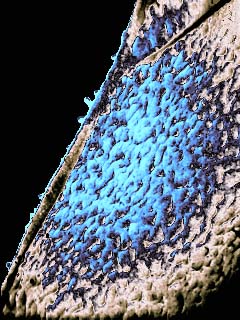 In 1993, Peter Jenniskens was awarded a National Research Council
Associateship Award to work with Dr. David F. Blake at NASA/Ames Research Center on the study of the
micro-structural and micro-chemical properties of ices and astrophysical implications. This included the study of
how structural changes in water ice can drive outgassing phenomena of comets and
affect the chemistry in UV photolysed interstellar ices. This
work led to an article (+ cover) in the August 1994 issue of Science. In subsequent work, the following results were obtained:
In 1993, Peter Jenniskens was awarded a National Research Council
Associateship Award to work with Dr. David F. Blake at NASA/Ames Research Center on the study of the
micro-structural and micro-chemical properties of ices and astrophysical implications. This included the study of
how structural changes in water ice can drive outgassing phenomena of comets and
affect the chemistry in UV photolysed interstellar ices. This
work led to an article (+ cover) in the August 1994 issue of Science. In subsequent work, the following results were obtained:
- Establishing the existence of a
"high-density amorphous form" of water ice, which must be the most common form of ice in the universe but is also the most difficult to make in the laboratory, in collaboration with D.F. Blake, M.A. Wilson and A. Pohorille. Read more.
- Studying of the
crystallization behaviour of amorphous water ice films, which provided the first evidence
that water above the glass transition is a "strong liquid" and
different from liquid water at room temperature, in collaboration with D.F. Blake. Read more.
Finding evidence of bulk
flow of water in the "strong" liquid regime, in collaboration with S. Banham, D.F. Blake and M.R.S. McCoustra. Read more.

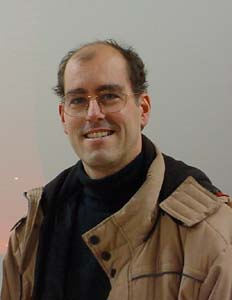
 Publications:
Publications:


 In 1993, Peter Jenniskens was awarded a National Research Council
Associateship Award to work with Dr. David F. Blake at NASA/Ames Research Center on the study of the
micro-structural and micro-chemical properties of ices and astrophysical implications. This included the study of
how structural changes in water ice can drive outgassing phenomena of comets and
affect the chemistry in UV photolysed interstellar ices. This
work led to an article (+ cover) in the August 1994 issue of Science. In subsequent work, the following results were obtained:
In 1993, Peter Jenniskens was awarded a National Research Council
Associateship Award to work with Dr. David F. Blake at NASA/Ames Research Center on the study of the
micro-structural and micro-chemical properties of ices and astrophysical implications. This included the study of
how structural changes in water ice can drive outgassing phenomena of comets and
affect the chemistry in UV photolysed interstellar ices. This
work led to an article (+ cover) in the August 1994 issue of Science. In subsequent work, the following results were obtained:
